Popular categories
Looking for a yarn?

65% Wool, 35% Alpaca
from 2.60 € /50g
Order DROPS Needles & Hooks
Clicking the ORDER button will redirect you to Mallia Kouvaria - pleko.gr. website
The yarn cost is calculated from the pattern’s smallest size and the yarn’s cheapest product type. Looking for an even better price? You might find it on the DROPS Deals!
Dinner Date
Knitted DROPS jacket with short rows, lace pattern and shawl collar in ”Lima”. Size: S - XXXL.
DROPS design: Pattern no li-060
Yarn group B
----------------------------------------------------------
Size: S - M - L - XL - XXL - XXXL
Materials:
DROPS LIMA from Garnstudio
550-600-700-750-800-900 colour no 6235, grey blue
DROPS CIRCULAR NEEDLE (60 or 80 cm) SIZE 4 mm - or size needed to get 21 sts x 42 rows in garter st = 10 x 10 cm.
DROPS BUTTON ARCHED (white), NO 522: 2 pieces in all sizes
-------------------------------------------------------
Alternative Yarn – See how to change yarns here
Yarn Groups A to F – Use the same pattern and change the yarn here
Yarn usage using an alternative yarn – Use our yarn converter here
-------------------------------------------------------
Women Jackets & Cardigansasymmetric bottom up lace sewn in sleeves shawl collar sideways v-neck

65% Wool, 35% Alpaca
from 2.60 € /50g
Order DROPS Needles & Hooks
Clicking the ORDER button will redirect you to Mallia Kouvaria - pleko.gr. website
The yarn cost is calculated from the pattern’s smallest size and the yarn’s cheapest product type. Looking for an even better price? You might find it on the DROPS Deals!
- English (UK/cm), Greece
- Česky - not translated
- Dansk
- Deutsch
- Eesti keel
- English (UK/cm)
- English (US/in)
- Español
- Français
- Íslenska
- Italiano
- Magyar
- Nederlands
- Norsk
- Polski
- Português
- Suomi
- Svenska
- English (UK/cm), Bulgaria
- English (UK/cm), Croatia
- English (UK/cm), Latvia
- English (UK/cm), Lithuania
- English (UK/cm), Romania
- English (UK/cm), Slovenia
- Česky, Slovakia - not translated
Pattern instructions
K all rows. 1 ridge = 2 rows K.
PATTERN: See diagram A.1. Diagram shows all rows in pattern from RS.
SHORT ROWS:
Work short rows on front piece to get a rounded edge on the piece.
Work short rows as follows:
Row 1-2: Work 45-50-55-60-65-70 sts, turn piece and work back.
Row 3-4: Work 42-47-52-57-62-67 sts, turn piece and work back.
Row 5-6: Work 40-45-50-55-60-65 sts, turn piece and work back.
Row 7-8: Work 37-42-47-52-57-62 sts, turn piece and work back.
Row 9-10: Work 35-40-45-50-55-60 sts, turn piece and work back.
Continue like this by working alternately 2 and 3 sts less on every turn until:
SIZE S: Row 35-36: Work 2 sts, turn and work back.
Repeat from row 1.
Row 37-38: Work over all 47 sts, turn and work back.
SIZE M: Row 39-40: Work 2 sts, turn and work back.
Row 41-42: Work over all 52 sts, turn and work back.
Repeat from row 1.
SIZE L: Row 43-44: Work 2 sts, turn and work back.
Row 45-46: Work over all 57 sts, turn and work back.
Repeat from row 1.
SIZE XL: Row 47-48: Work 2 sts, turn and work back.
Row 49-50: Work over all 62 sts, turn and work back.
Repeat from row 1.
SIZE XXL: Row 51-52: Work 2 sts, turn and work back.
Row 53-54: Work over all 67 sts, turn and work back.
Repeat from row 1.
SIZE XXXL: Row 55-56: Work 2 sts, turn and work back.
Row 57-58: Work over all 72 sts, turn and work back.
Repeat from row 1.
BUTTONHOLES:
Dec for buttonholes on right band. 1 buttonhole = K tog 2nd and 3rd st from mid front, then make 1 YO. Dec for buttonholes when piece measures 1 and 5 cm in all sizes (after short rows are done).
----------------------------------------------------------
BACK PIECE:
Worked in 2 parts.
BOTTOM PART:
Cast on 47-52-57-62-67-72 sts on circular needle size 4 mm with Lima. Work ridges in GARTER ST – see explanation above – back and forth over all sts until piece measures 40-44-48-53-58-65 cm. REMEMBER THE KNITTING TENSION Cast off.
TOP PART:
Pick up 1 st in every ridge along on long side on bottom part. On next row (K from WS) adjust no of sts to 86-93-100-114-121-135. Continue to work as follows (from RS): 1 edge st in garter st, A.1 over the next 84-91-98-112-119-133 sts, 1 edge st in garter st. Work until piece measures 39-40-41-42-43-44 cm in total (measured in the side from bottom of jacket). Now cast off in each side for armholes. Cast off at beg of every row: 3 sts 1-1-1-2-2-2 times, 2 sts 0-1-2-3-4-6 times and 1 st 1-1-2-3-3-5 times = 78-81-82-84-87-89 sts. Continue to work until piece measures 56-58-60-62-64-66 cm. Now cast off the middle 18-19-20-20-21-23 sts for neck. On next row cast off 1 st towards the neck = 29-30-30-31-32-32 sts remain on each shoulder. Continue to work until piece measures 58-60-62-64-66-68 cm. Cast off.
RIGHT FRONT PIECE:
Worked back and forth on needle in garter st, i.e. K all rows. Cast on 47-52-57-62-67-72 sts on circular needle size 4 mm with Lima. Work SHORT ROWS - see explanation above (1st row = RS). Work Short rows (1st to 38th-42nd-46th-50th-54th-58th row) 5 times in total, the curved edge measures approx. 45-50-55-60-64-69 cm at the edge. Then work back and forth over all sts. Dec for BUTTONHOLES - see explanation above. Work until piece measures 39-40-41-42-43-44 cm (measured in the side from bottom of jacket). On next row from WS beg cast off for armhole in the side as on back piece = 43-46-48-47-50-49 sts. Continue to work until piece measures 58-60-62-64-66-68 cm. Now cast off the outermost 29-30-30-31-32-32 sts in the side for shoulder = 14-16-18-16-18-17 sts remain on needle for collar. Work rest of row. Then work short rows as follows (1st row = RS): * Work back and forth over all sts, work back and forth over 7-8-9-8-9-8 sts towards mid front *, repeat from *-* until collar measures approx. 7-7-7-8-8-9 cm (measured in the shorter side) from where shoulder was cast off. Cast off.
LEFT FRONT PIECE:
Cast on 47-52-57-62-67-72 sts on circular needle size 4 mm with Lima. K 1 row from RS. Then work as right front piece but reversed (1st row in short rows is from WS).
SLEEVE:
The sleeve is worked back and forth on circular needle. Cast on 44-44-51-51-58-58 sts (incl 1 edge st in each side) on circular needle size 4 mm with Lima. Work 2 ridges, then work as follows: 1 edge st in garter st, A.1 over the next 42-42-49-49-56-56 sts, finish with 1 edge st in garter st. Work A.1 3 times vertically, then work in stocking st with 1 st in garter st in each side. When piece measures 8 cm, inc 1 st in each side, repeat inc every 3-2½-2½-2-2-1½ cm 11-14-13-16-16-19 more times = 68-74-79-85-92-98 sts. When piece measures 48-47-47-46-46-44 cm (NOTE! Shorter measurements in the larger sizes because of longer sleeve cap and wider shoulders), cast off in each side for sleeve cap. Cast off at beg of every row as follows: 3 sts 1 time and 2 sts 4-4-5-5-6-6 times and 1 st 0-1-1-1-1-3 times. Then cast off 2 sts in each side until piece measures 54-54-55-55-56-56 cm, cast off 3 sts in each side 1 time. Cast off the remaining sts, piece measures approx. 55-55-56-56-57-57 cm. Make another sleeve.
ASSEMBLY:
Sew the shoulder seams. Sew in sleeves. Sew sleeve and side seams in one inside 1 edge st. Sew collar tog mid back and sew the neck dec on back piece. Sew the buttons on to left front piece.
Diagram

|
= K from RS, P from WS |

|
= K 2 tog |

|
= slip 1 st as if to K, K 1, psso |

|
= 1 YO between 2 sts |
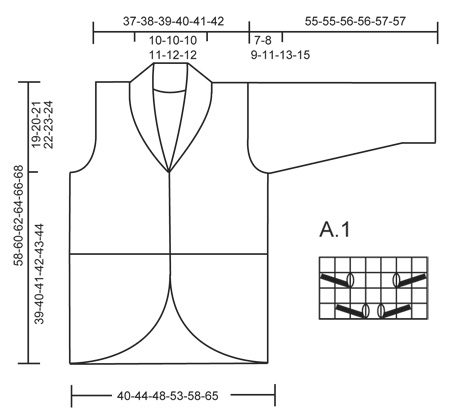
What can you do with our patterns? You can share DROPS patterns online, using the pattern original picture, materials, name and number. But you are NOT ALLOWED to reproduce the complete pattern digitally in any way. Yarn stores are welcome to use the DROPS pattern database to promote the sale of our assortment. You can print out our patterns, make as many copies as you’d like. The only thing we ask is that you don't make any changes / additions to the original printed document. And that the patterns according to the DROPS philosophy are given out to the consumers for free. Editorials that wish to publish our patterns in printed books or magazines can contact us for more information. The sale of garments based on DROPS patterns is permitted as long as they are sold as single items or per order. Further commercial use of the patterns is not permitted. It has to be clearly stated that the garment is made based on a design from DROPS DESIGN. The use of clothing labels of which DROPS DESIGN forms part is conditioned by the inclusion of the following text: “A DROPS DESIGN made by …..”. The use of DROPS photos for marketing purposes/sales is only permitted in connection with the use/sale of DROPS products. The photos may not be cut or edited and the logo should be clearly visible.
We reserve the right to withdraw the permission for use of our patterns at any time, notwithstanding the reason.
Each of our patterns has specific tutorial videos to help you.
These step-by-step tutorials might also help you:
Why is the knitting/crochet tension so important?
Knitting tension is what determines the final measurements of your work, and is usually measured per 10 x 10 cm. It is provided like so: number of stitches in width x number of rows in height - eg: 19 stitches x 26 rows = 10 x 10 cm.
The knitting tension is very individual; some people knit/crochet loosely while others work tightly. You adjust the knitting tension with the needle size, which is why the suggested needle size is only meant as a guide! You need to adjust this (up or down) to ensure that YOUR knitting tension matches the knitting tension provided in the pattern. If you work with a different knitting tension than provided you will have a different yarn consumption, and your work will have different measurements than what the pattern suggests.
The knitting tension also determines which yarns can replace each other. As long as you achieve the same knitting tension you can replace one yarn with another.
See DROPS lesson: How to measure your tension/gauge
See DROPS video: How to make a gauge tension swatch
How do I know how many balls of yarn I need?
The required amount of yarn is provided in grams, eg: 450 g. To calculate how many balls you’ll need you first need to know how many grams are in 1 ball (25g, 50g or 100g). This information is available if you click on the individual yarn quality on our pages. Divide the amount required with the amount of each ball. For example, if each ball is 50g (the most common amount), the calculation will be as follows: 450 / 50 = 9 balls.
Can I use a different yarn than what the pattern suggests?
The important thing when changing from one yarn to another is that the knitting/crochet tension remains the same. This is so that the measurements of the finished piece will be the same as on the sketch provided. It is easier to achieve the same knitting tension using yarns from the same yarn group. It is also possible to work with multiple strands of a thinner yarn to achieve the knitting tension of a thicker one. Please try our yarn converter. We recommend you to always work a test swatch.
Please NOTE: when changing yarn the garment might have a different look and feel to the garment in the photo, due to individual properties and qualities of each yarn.
See DROPS lesson: Can I use a different yarn than the one mentioned in the pattern?
What are the yarn groups?
All our yarns are categorised into yarn groups (from A to F) according to thickness and knitting tension – group A contains the thinnest yarns and group F the thickest. This makes it easier for you to find alternative yarns to our patterns, should you wish to switch yarn. All yarns within the same group have a similar knitting tension and can easily replace each other. However, different yarn qualities have different structures and properties which will give the finished work a unique look and feel.
How do I use the yarn calculator?
At the top of all our patterns you’ll find a link to our yarn calculator, which is a helpful tool should you wish to use a different yarn than suggested. By filling in the yarn quality you wish to replace, the amount (in your size) and number of strands, the calculator will present good alternative yarns with the same knitting tension. Additionally it will tell you how much you’ll require in the new qualities and whether you’ll need to work with multiple strands. Most skeins are 50g (some are 25g or 100g).
If the pattern is worked with multiple colours, every colour will have to be calculated separately. Similarly, if the pattern is worked with several strands of different yarns (for example 1 strand Alpaca and 1 strand Kid-Silk) you will have to find alternatives for each, individually.
Why do you show discontinued yarns in the patterns?
Since different yarns have different qualities and textures we have chosen to keep the original yarn in our patterns. However, you can easily find options among our available qualities by using our yarn calculator, or simply pick a yarn from the same yarn group.
It is possible that some retailers still have discontinued yarns in stock, or that someone has a few skeins at home that they would like to find patterns for.
The yarn calculator will provide both alternative yarn as well as required amount in the new quality.
What size should I knit?
If you think it's hard to decide what size to make, it can be a good idea to measure a garment you own already and like the size of. Then you can pick the size by comparing those measures with the ones available in the pattern's size chart.
You'll find the size chart at the bottom of the pattern.
See DROPS lesson: How to read size chart
Why do I get the wrong knitting tension with the suggested needle size?
The needle size provided in the pattern serves only as a guide, the important thing is to follow the knitting tension. And since knitting tension is very individual, you will have to adjust the needle size to ensure that YOUR tension is the same as in the pattern – maybe you’ll have to adjust 1, or even 2 needle sizes, up or down to achieve the correct tension. For this, we recommend that you work test swatches.
Should you work with a different knitting tension than the one provided, the measurements of the finished garment might deviate from the measurement sketch.
See DROPS lesson: How to measure your tension/gauge
See DROPS video: How to make a tension/gauge swatch
Why is the pattern worked top-down?
Working a garment top-down provides more flexibility and room for personal adjustment. For example it is easier to try the garment on while working, as well as making adjustments to length of yoke and shoulder caps.
The instructions are carefully explaining every step, in the correct order. Diagrams are adjusted to the knitting direction and are worked as usual.
How do I work according to a knitting diagram?
The diagram depicts all rows/rounds, and every stitch seen from the right side. It is read from bottom to top, from right to left. 1 square = 1 stitch.
When working back and forth, every other row is worked from the right side and every other row is worked from the wrong side. When working from the wrong side, the diagram will have to be worked reversed: from left to right, knit stitches are purled, purl stitches are knit etc.
When working in the round every round is worked from the right side and the diagram are worked from right to left on all rounds.
See DROPS lesson: How to read knitting diagrams
How do I work according to a crochet diagram?
The diagram depicts all rows/rounds, and every stitch seen from the right side. It is worked from bottom to top, from right to left.
When working back and forth every other row is worked from the right side: from right to left and every other row is worked from the wrong side: from left to right.
When working in the round, every row in the diagram are worked from the right side, from right to left.
When working a circular diagram you start in the middle and work your way outwards, counter clockwise, row by row.
The rows usually start with a given number of chain stitches (equivalent to the height of the following stitch), this will either be depicted in the diagram or explained in the pattern.
See DROPS lesson: How to read crochet diagrams
How do I work several diagrams simultaneously on the same row/round?
Instructions for working several diagrams after each other on the same row/round, will often be written like so: “work A.1, A.2, A.3 a total of 0-0-2-3-4 times". This means you work A.1 once, then A.2 is worked once, and A.3 is repeated (in width) the number of times provided for your size – in this case like so: S = 0 times, M = 0 times, L=2 times, XL= 3 times and XXL = 4 times.
The diagrams are worked as usual: begin with the first row in A.1, then work the first row in A.2 etc.
See DROPS lesson: How to read knitting diagrams
See DROPS lesson: How to read crochet diagrams
Why are the sleeves shorter in larger sizes?
The total width of the garment (from wrist-to-wrist) will be larger in the larger sizes, despite the actual sleeves being shorter. The larger sizes have longer sleeve caps and wider shoulders, so there will be a good fit in all sizes.
Where on the garment is the length measured?
The measurement sketch/schematic drawing provides information regarding the full length of the garment. If it’s a jumper or a jacket the length is measured from the highest point on the shoulder closest to the neckline, and straight down to the bottom of the garment. It is NOT measured from the tip of shoulder. Similarly, the length of yoke is measured from the highest point on the shoulder and down to where yoke is split into body and sleeves.
On a jacket measures are never taken along bands, unless specifically stated. Always measure inside band stitches when measuring the length.
See DROPS lesson: How to read a schematic drawing
What is a repeat?
Diagrams are often repeated on the round or in height. 1 repeat is the diagram the way it appears in the pattern. If it says to work 5 repeats of A.1 in the round, then you work A.1 a total of 5 times after/next to each other in the round. If it says to work 2 repeats of A.1 vertically/in height you work the entire diagram once, then begin again at the start and work the entire diagram one more time.
Why does the piece start with more chain stitches than it’s worked with?
Chain stitches are slightly narrower than other stitches and to avoid working the cast-on edge too tight, we simply chain more stitches to begin with. The stitch count will be adjusted on the following row to fit the pattern and measurement sketch.
Why increase before the rib edge when the piece is worked top-down?
The rib edge is more elastic and will contract slightly compared to, for example, stocking stitch. By increasing before the rib edge, you avoid a visible difference in width between the rib edge and the rest of the body.
Why increase in the cast-off edge?
It’s very easy to cast off too tightly, and by making yarn overs while casting off (and simultaneously casting these off) you avoid a too tight cast off edge.
See DROPS video: How to bind off with yarn overs (yo)
How do I increase/decrease on every 3rd and 4th row/round alternately?
To achieve an even increase (or decrease) you can increase on, for example: every 3rd and 4th row alternately, like so: work 2 rows and increase on the 3rd row, work 3 rows and increase on the 4th. Repeat this until the increase is complete.
See DROPS lesson: Increase or decrease 1 st on every 3rd and 4th row alternately
How can I work a jacket in the round instead of back and forth?
Should you prefer to work in the round instead of back and forth, you may of course adjust the pattern. You’ll need to add steeks mid-front (usually 5 stitches), and follow the instructions. When you would normally turn and work from the wrong side, simply work across the steek and continue in the round. At the end you’ll cut the piece open, pick up stitches to work bands, and cover the cut edges.
See DROPS video: How to knit steeks and cut open
Can I work a jumper back and forth instead of in the round?
Should you prefer to work back and forth instead of in the round, you may of course adjust the pattern so you work the pieces separately and then assemble them at the end. Divide the stitches for the body in 2, add 1 edge stitch in each side (for sewing) and work the front and back pieces separately.
See DROPS lesson: Can I adapt a pattern for circular needles into straight needles?
Why is the pattern slightly different than what I see in the photo?
Pattern repeats can vary slightly in the different sizes, in order to get the correct proportions. If you’re not working the exact same size as the garment in the photo, yours might deviate slightly. This has been carefully developed and adjusted so that the complete impression of the garment is the same in all sizes.
Make sure to follow instructions and diagrams for your size!
How do I make a women’s size garment into a men’s size one?
If you have found a pattern you like which is available in women’s size it’s not very difficult to convert it to men’s size. The biggest difference will be the length of sleeves and body. Start working on the women size that you think would fit across the chest. The additional length will be worked right before you cast off for the armhole/sleeve cap. If the pattern is worked top-down you can add the length right after the armhole or before the first decrease on sleeve.
Regarding additional yarn amount, this will depend on how much length you add, but it is better with a skein too many than too few.
How do I prevent a hairy garment from shedding?
All yarns will have excess fibres (from production) that might come off as lint or shedding. Brushed yarns (ie hairier yarns) have more of these loose, excess fibres, causing more shedding.
Shedding also depends on what is worn under or over the garment, and whether this pulls at the yarn fibres. It’s therefore not possible to guarantee that there will be no shedding
Below are some tips on how to get the best result when working with hairier yarns:
1. When the garment is finished (before you wash it) shake it vigorously so the looser hairs come off. NOTE: do NOT use a lint roller, brush or any method that pulls at the yarn.
2. Place the garment in a plastic bag and put it in your freezer - the temperature will cause the fibres to become less attached to each other, and excess fibres will come off easier.
3. Leave in the freezer for a few hours before taking it out and shaking it again.
4. Wash the garment according to the instructions on the yarn label.
Why does my garment pill?
Pilling is a natural process that happens to even the most exclusive of fibers. It's a natural sign of wear and tear that is hard to avoid, and that is most visible in high friction areas of your garment like a sweater's arms and cuffs.
You can make your garment look as new by removing the pilling, using a fabric comb or a pill/lint remover.
In the meantime, you can read the questions and answers that others have left to this pattern or join the DROPS Workshop on Facebook to get help from fellow knitters/crocheters!
You might also like...
Dinner Date |
|||||||||||||
 |
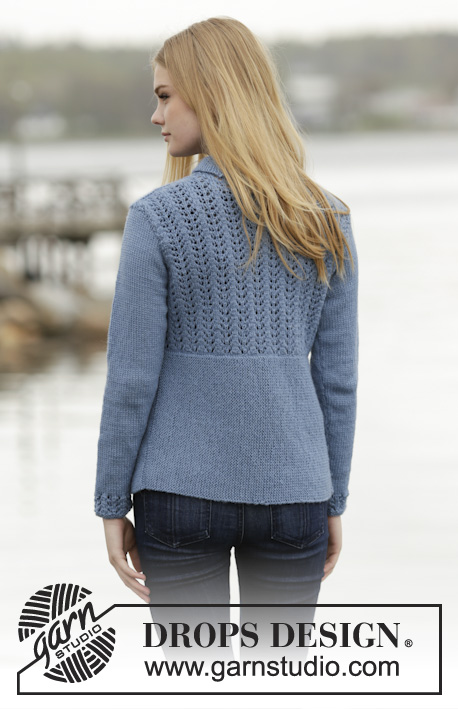 |
||||||||||||
Knitted DROPS jacket with short rows, lace pattern and shawl collar in ”Lima”. Size: S - XXXL.
DROPS 165-24 |
|||||||||||||
|
GARTER ST (back and forth): K all rows. 1 ridge = 2 rows K. PATTERN: See diagram A.1. Diagram shows all rows in pattern from RS. SHORT ROWS: Work short rows on front piece to get a rounded edge on the piece. Work short rows as follows: Row 1-2: Work 45-50-55-60-65-70 sts, turn piece and work back. Row 3-4: Work 42-47-52-57-62-67 sts, turn piece and work back. Row 5-6: Work 40-45-50-55-60-65 sts, turn piece and work back. Row 7-8: Work 37-42-47-52-57-62 sts, turn piece and work back. Row 9-10: Work 35-40-45-50-55-60 sts, turn piece and work back. Continue like this by working alternately 2 and 3 sts less on every turn until: SIZE S: Row 35-36: Work 2 sts, turn and work back. Repeat from row 1. Row 37-38: Work over all 47 sts, turn and work back. SIZE M: Row 39-40: Work 2 sts, turn and work back. Row 41-42: Work over all 52 sts, turn and work back. Repeat from row 1. SIZE L: Row 43-44: Work 2 sts, turn and work back. Row 45-46: Work over all 57 sts, turn and work back. Repeat from row 1. SIZE XL: Row 47-48: Work 2 sts, turn and work back. Row 49-50: Work over all 62 sts, turn and work back. Repeat from row 1. SIZE XXL: Row 51-52: Work 2 sts, turn and work back. Row 53-54: Work over all 67 sts, turn and work back. Repeat from row 1. SIZE XXXL: Row 55-56: Work 2 sts, turn and work back. Row 57-58: Work over all 72 sts, turn and work back. Repeat from row 1. BUTTONHOLES: Dec for buttonholes on right band. 1 buttonhole = K tog 2nd and 3rd st from mid front, then make 1 YO. Dec for buttonholes when piece measures 1 and 5 cm in all sizes (after short rows are done). ---------------------------------------------------------- BACK PIECE: Worked in 2 parts. BOTTOM PART: Cast on 47-52-57-62-67-72 sts on circular needle size 4 mm with Lima. Work ridges in GARTER ST – see explanation above – back and forth over all sts until piece measures 40-44-48-53-58-65 cm. REMEMBER THE KNITTING TENSION Cast off. TOP PART: Pick up 1 st in every ridge along on long side on bottom part. On next row (K from WS) adjust no of sts to 86-93-100-114-121-135. Continue to work as follows (from RS): 1 edge st in garter st, A.1 over the next 84-91-98-112-119-133 sts, 1 edge st in garter st. Work until piece measures 39-40-41-42-43-44 cm in total (measured in the side from bottom of jacket). Now cast off in each side for armholes. Cast off at beg of every row: 3 sts 1-1-1-2-2-2 times, 2 sts 0-1-2-3-4-6 times and 1 st 1-1-2-3-3-5 times = 78-81-82-84-87-89 sts. Continue to work until piece measures 56-58-60-62-64-66 cm. Now cast off the middle 18-19-20-20-21-23 sts for neck. On next row cast off 1 st towards the neck = 29-30-30-31-32-32 sts remain on each shoulder. Continue to work until piece measures 58-60-62-64-66-68 cm. Cast off. RIGHT FRONT PIECE: Worked back and forth on needle in garter st, i.e. K all rows. Cast on 47-52-57-62-67-72 sts on circular needle size 4 mm with Lima. Work SHORT ROWS - see explanation above (1st row = RS). Work Short rows (1st to 38th-42nd-46th-50th-54th-58th row) 5 times in total, the curved edge measures approx. 45-50-55-60-64-69 cm at the edge. Then work back and forth over all sts. Dec for BUTTONHOLES - see explanation above. Work until piece measures 39-40-41-42-43-44 cm (measured in the side from bottom of jacket). On next row from WS beg cast off for armhole in the side as on back piece = 43-46-48-47-50-49 sts. Continue to work until piece measures 58-60-62-64-66-68 cm. Now cast off the outermost 29-30-30-31-32-32 sts in the side for shoulder = 14-16-18-16-18-17 sts remain on needle for collar. Work rest of row. Then work short rows as follows (1st row = RS): * Work back and forth over all sts, work back and forth over 7-8-9-8-9-8 sts towards mid front *, repeat from *-* until collar measures approx. 7-7-7-8-8-9 cm (measured in the shorter side) from where shoulder was cast off. Cast off. LEFT FRONT PIECE: Cast on 47-52-57-62-67-72 sts on circular needle size 4 mm with Lima. K 1 row from RS. Then work as right front piece but reversed (1st row in short rows is from WS). SLEEVE: The sleeve is worked back and forth on circular needle. Cast on 44-44-51-51-58-58 sts (incl 1 edge st in each side) on circular needle size 4 mm with Lima. Work 2 ridges, then work as follows: 1 edge st in garter st, A.1 over the next 42-42-49-49-56-56 sts, finish with 1 edge st in garter st. Work A.1 3 times vertically, then work in stocking st with 1 st in garter st in each side. When piece measures 8 cm, inc 1 st in each side, repeat inc every 3-2½-2½-2-2-1½ cm 11-14-13-16-16-19 more times = 68-74-79-85-92-98 sts. When piece measures 48-47-47-46-46-44 cm (NOTE! Shorter measurements in the larger sizes because of longer sleeve cap and wider shoulders), cast off in each side for sleeve cap. Cast off at beg of every row as follows: 3 sts 1 time and 2 sts 4-4-5-5-6-6 times and 1 st 0-1-1-1-1-3 times. Then cast off 2 sts in each side until piece measures 54-54-55-55-56-56 cm, cast off 3 sts in each side 1 time. Cast off the remaining sts, piece measures approx. 55-55-56-56-57-57 cm. Make another sleeve. ASSEMBLY: Sew the shoulder seams. Sew in sleeves. Sew sleeve and side seams in one inside 1 edge st. Sew collar tog mid back and sew the neck dec on back piece. Sew the buttons on to left front piece. |
|||||||||||||
Diagram explanations |
|||||||||||||
|
|||||||||||||

|
|||||||||||||
|
Have you made this or any other of our designs? Tag your pictures in social media with #dropsdesign so we can see them! Do you need help with this pattern?You'll find tutorial videos, a Comments/Questions area and more by visiting the pattern on garnstudio.com. © 1982-2024 DROPS Design A/S. We reserve all rights. This document, including all its sub-sections, has copyrights. Read more about what you can do with our patterns at the bottom of each pattern on our site. |
|||||||||||||
With over 40 years in knitting and crochet design, DROPS Design offers one of the most extensive collections of free patterns on the internet - translated to 17 languages. As of today we count 304 catalogues and 11422 patterns - 11422 of which are translated into English (UK/cm).
We work hard to bring you the best knitting and crochet have to offer, inspiration and advice as well as great quality yarns at incredible prices! Would you like to use our patterns for other than personal use? You can read what you are allowed to do in the Copyright text at the bottom of all our patterns. Happy crafting!







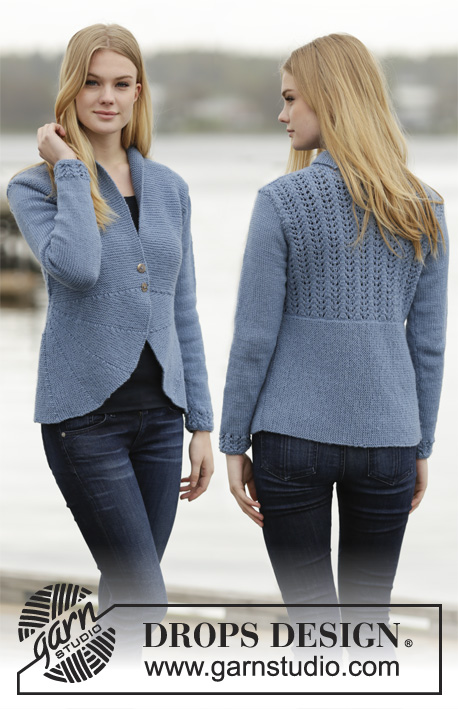


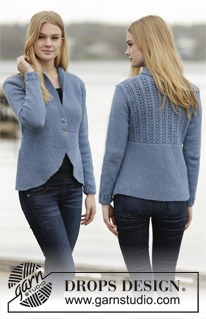




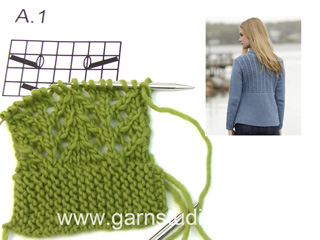






























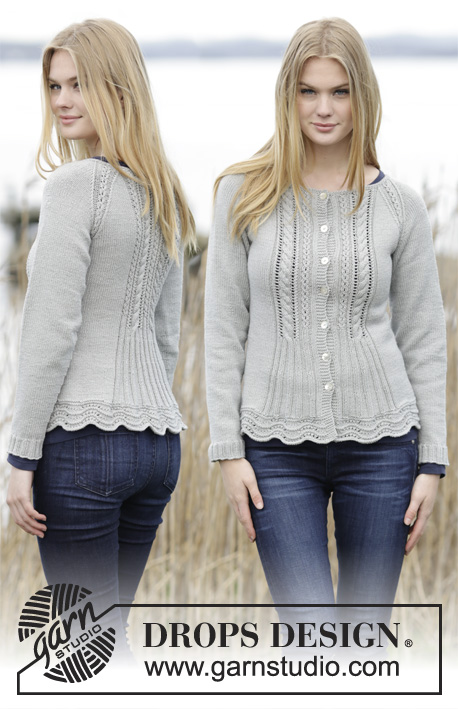
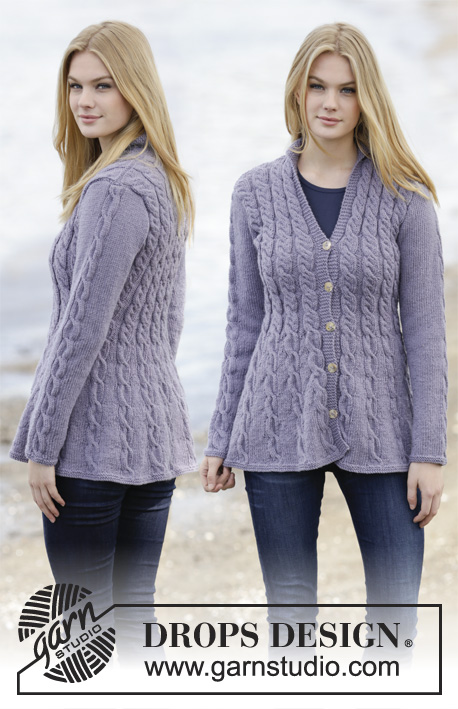
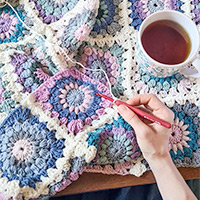
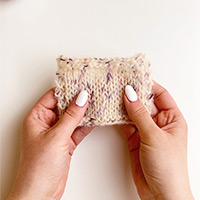
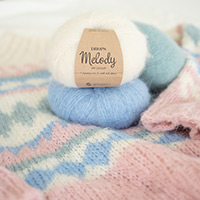
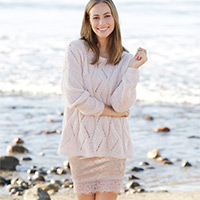
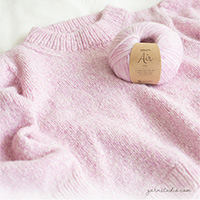
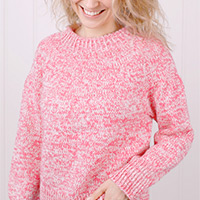
Comments / Questions (55)
Eine einmalige Jacke! Ein wahres Schmuckstück! Passt perfekt. Danke für die genaue Anleitung. Lima ist ein herrliches Garn! Ich habe noch ein drittes Knopfloch eingearbeitet. Das sieht noch schöner aus.
31.05.2016 - 10:03Jeg har styr på vendepinden, men kan ikke få den fremtrædende linje og maske på venstre forstykke som på højre. Jeg har og andre har prøvet på mange måder. Kan der være en fejl i opskriften??? Håber snart på en løsning. Vh. Vini
25.02.2016 - 11:08DROPS Design answered:
Hej, Hvis du på venstre forstykke starter vendingerne i modsat side, så vil du få buen i den anden side og altså mod midt foran. Selve overgangen til buerne vil ikke se nøjagtig ligedan ud da den ene strikkes fra vrangen, men da alt strikkes i retstrik er forskellen ikke større end det man kan se på billedet. God fornøjelse!
25.02.2016 - 15:29Nu prøver jeg igen. Vil det ikke være en ide at I laver en vidio som viser hvordan begge forstykker strikkes så de bliver som på billedet???? Kan lære at vi er flere der har samme problem. Hilsen Vini. Su gerne hurtigt.
20.02.2016 - 19:58DROPS Design answered:
Hej Vini, Er det vendepindene du ikke forstår, her ser du en video med dem:
DROPS Knitting Tutorial: How to knit short rows in garter st - basic from Garnstudio Drops design on Vimeo.
24.02.2016 - 15:42Beim rechten Vorderteil sieht die verkürzte Reihe anders aus als beim linken Vorderteil. Was mache ich falsch?
17.01.2016 - 17:46DROPS Design answered:
Liebe Uta, haben Sie sich alle unsere Videos zum Thema Verkürzte Reihen angeschaut? Mit diesem Wissen sollten Sie dann die verkürzten Reihen ausführen können.
02.03.2016 - 09:36Hjælp, jeg kan ikke få venstre forstykke rigtigt ,stribeeffekten kommer på vrangsiden? Hilsen Vini
17.01.2016 - 11:15DROPS Design answered:
Hej Vini, Jo du lader samme side være ret fra retsiden som højre forstykke, men du strikker selve vendingerne i den anden side af arbejdet. God fornøjelse!
27.01.2016 - 11:39Ik weet inmiddels dat het vest ook op gewone naalden gebreid kan worden.
02.01.2016 - 09:49Ich bin jetzt am Rückenteil, wo die Abnahmen für die Ärmel gemacht werden sollen. Wenn ich die Abnahmen mache und dann weiter im Muster A.1 stricke verschiebt sich das Muster. Wie muss ich nach den Abnahmen weiterstricken in A.1, damit sich das Muster nicht versetzt? Vielen Dank Peggy
23.11.2015 - 12:53DROPS Design answered:
Sie müssen darauf achten, dass Sie bei den M, die nicht durch die Armausschnitte abgekettet werden, auf jeden Fall im Muster bleiben. Die M, die durch das Abketten nicht mehr im Muster aufgehen, stricken Sie einfach glatt re. Orientieren Sie sich also am begonnen Muster und achten Sie darauf, dass die Mustersätze weiterhin übereinander zu liegen kommen. Sie können sich zur besseren Orientierung die ersten Mustersätze der R jeweils mit Fäden markieren, dann sehen Sie direkt, wo ein Mustersatz beginnt.
30.11.2015 - 12:42Sihem wrote:
Bonsoir; Merci pour ce joli modèle, je voudrais savoir s'il y a un moyen pour avoir ce gilet avec une longueur superieure (si c'est faisable). Merci
15.11.2015 - 20:45DROPS Design answered:
Bonjour Sihem, vous pouvez probablement ajuster à votre convenance, demandez conseil à votre magasin DROPS il pourra vous aider. Bon tricot!
16.11.2015 - 09:48I am knitting the pattern in size XXL. Currently doing the decreases for the armholes on the back of the body. The stitch count at the beginning is 121sts, and it should be 87sts when the armhole decreases are complete. If I bind off as instructed at the beginning of every row, there are only 17 decreases, leaving 104 stitches. Did I miss something?
06.11.2015 - 22:14DROPS Design answered:
Dear Jenniver, bind off for armhole have to be done on each side (= at the beg of every row both from RS and from WS): 3 sts 2 times x 2 sides, 2 sts 4 times x 2 sides and 1 st 3 timesx 2 sides = 17 sts x 2 sides= 34 sts bound off for armhole in total. 121 -34= 87 sts. Happy knitting!
09.11.2015 - 09:38Can you please help me with the back of the neck of this pattern, i;m not sure how the back neck should be stitched. The pattern says " sew the neck on dec on back piece" but i;m not sure what this means. Can you help please? Thank you
30.10.2015 - 16:36DROPS Design answered:
Dear Mrs Church, the collar will be sewn tog (from both front pieces), then sew along the neckline on back piece (sts cast off and dec) - see also video below (different collar - without short rows - but same technique).
31.10.2015 - 17:33